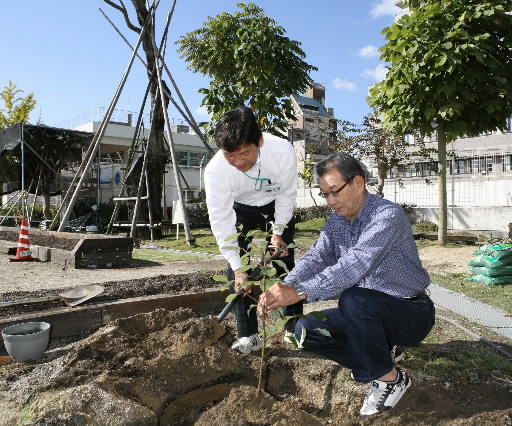“Forest of Peace” is created with A-bombed trees at elementary school in Hiroshima
Nov. 5, 2012
by Daisuke Yamamoto, Staff Writer
A site dubbed the “Forest of Peace,” which features A-bombed trees and trees grown from their seeds, will be completed on the grounds of Honkawa Elementary School in November. On October 29, a second-generation A-bombed camphor tree, the sixth and final tree, was planted on the grounds. Honkawa Elementary School, located in Naka Ward, is the school closest to the A-bomb’s hypocenter. With a wish for the elimination of nuclear weapons, the “forest” will become a new venue for promoting peace.
The trees stand in an area of roughly 50 square meters on the western section of the school grounds. Two ailanthus trees have been located here for years: one tree, about 12 meters tall, survived the atomic bombing of August 1945, while the other, about eight meters tall, sprouted in 1946. Second-generation A-bombed aogiri trees, or Chinese parasol trees, each about five meters tall, were replanted on the school grounds in 1992.
After becoming the principal of Honkawa Elementary School in April 2012, Kazunori Kono conceived the idea of creating a “forest” by planting more A-bombed trees. The principal solicited donations for the project and received two contributions.
On October 29, a second-generation camphor tree, born from a tree that was exposed to the atomic bomb at a location about 2.1 kilometers from the hypocenter, was planted on the school grounds. The tree stands just over half a meter high. Chikara Horiguchi, 67, a tree doctor and a resident of Nishi Ward, cultivated it from a seed at his home. “I hope the tree will be useful for peace education,” Mr. Horiguchi said.
In August, the school received a ring-cupped oak, about five meters tall, that had stood outside the home of Yuri Hiraki, a painter and resident of Naka Ward.
Teachers and students of the school will continue working on the “forest” by weeding the grounds and adding signs. A ceremony to celebrate its completion will be held at the school on November 11.
A building which survived the atomic bombing, as close as 410 meters from the hypocenter, still stands on the grounds of Honkawa Elementary School. Today the building is used to house a peace museum, which welcomes some 20,000 people each year, many of them students visiting Hiroshima on school trips. “Our students will guide visitors to the Forest of Peace,” Principal Kono said. “Through this activity, I hope they will reflect on the preciousness of peace.”
(Originally published on October 30, 2012)
A site dubbed the “Forest of Peace,” which features A-bombed trees and trees grown from their seeds, will be completed on the grounds of Honkawa Elementary School in November. On October 29, a second-generation A-bombed camphor tree, the sixth and final tree, was planted on the grounds. Honkawa Elementary School, located in Naka Ward, is the school closest to the A-bomb’s hypocenter. With a wish for the elimination of nuclear weapons, the “forest” will become a new venue for promoting peace.
The trees stand in an area of roughly 50 square meters on the western section of the school grounds. Two ailanthus trees have been located here for years: one tree, about 12 meters tall, survived the atomic bombing of August 1945, while the other, about eight meters tall, sprouted in 1946. Second-generation A-bombed aogiri trees, or Chinese parasol trees, each about five meters tall, were replanted on the school grounds in 1992.
After becoming the principal of Honkawa Elementary School in April 2012, Kazunori Kono conceived the idea of creating a “forest” by planting more A-bombed trees. The principal solicited donations for the project and received two contributions.
On October 29, a second-generation camphor tree, born from a tree that was exposed to the atomic bomb at a location about 2.1 kilometers from the hypocenter, was planted on the school grounds. The tree stands just over half a meter high. Chikara Horiguchi, 67, a tree doctor and a resident of Nishi Ward, cultivated it from a seed at his home. “I hope the tree will be useful for peace education,” Mr. Horiguchi said.
In August, the school received a ring-cupped oak, about five meters tall, that had stood outside the home of Yuri Hiraki, a painter and resident of Naka Ward.
Teachers and students of the school will continue working on the “forest” by weeding the grounds and adding signs. A ceremony to celebrate its completion will be held at the school on November 11.
A building which survived the atomic bombing, as close as 410 meters from the hypocenter, still stands on the grounds of Honkawa Elementary School. Today the building is used to house a peace museum, which welcomes some 20,000 people each year, many of them students visiting Hiroshima on school trips. “Our students will guide visitors to the Forest of Peace,” Principal Kono said. “Through this activity, I hope they will reflect on the preciousness of peace.”
(Originally published on October 30, 2012)








